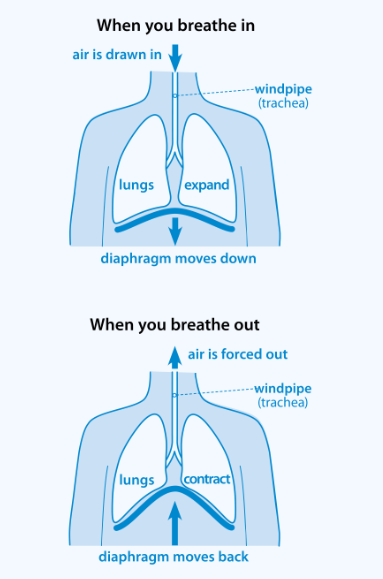Breathing is mostly an unconscious activity. However, there are, several effective techniques to help you breathe better, relax, and reduce stress. This article investigates what occurs within your body when you breathe. It also includes some suggestions and breathing exercises to improve lung capacity, and as a result, help you maintain a healthy lifestyle.
What Happens When You Breathe?
Breathing, also known as respiration, is a complicated process of air exchange. The following body parts are primarily involved in the process:

The Lungs
These are two spongy organs located on either side of the chest. When a person breathes in, their lungs expand, and when they breathe out, their lungs constrict. Each lung is enclosed within a thin membrane called the pleura, which protects the lung and allows it to move while breathing.
The Diaphragm
This is a narrow muscle found underneath the lungs and above the abdominal cavity. Its up-and-down movement aids in the contraction and expansion of the lungs.
The Intercostal Muscles
Located between the ribs, these muscles, aid breathing by helping the chest cavity expand and contract.
The Process of Breathing
While breathing, the lungs, diaphragm, and intercostal muscles work together.

Breathing In
While breathing in, the diaphragm contracts and slides down. This in turn allows the chest cavity to expand, enabling the lungs to inflate and fill with air. As your lungs expand, warm and wet air enters your nose or mouth. It then makes its way down your windpipe, then to your bronchial tubes (which connect your windpipe to your lungs). When air enters your lungs, it travels to the alveoli (air sacs), where oxygen is released into your bloodstream.
For a more detailed explanation, you may watch the video linked below.
Breathing Out
While breathing out, the diaphragm relaxes, lowering the amount of space in the chest cavity. As a result, the lungs collapse and expel the air through your nose or mouth.
How to Breathe Properly?
Although breathing is a natural action, several people tend to breathe incorrectly. The American Lung Association (ALA) offers the following tips on proper breathing.
Make Use of Your Nose
Inhaling through the nose helps slow down your breathing, allowing your lungs to perform more efficiently. Furthermore, it promotes the absorption of nitric oxide, which aids in the transfer of oxygen throughout the body. Breathing via the nose also helps the nostrils filter pollutants and allergens from the air, keeping them from entering the body. However, if a person is active or has sinus congestion, breathing via the mouth may be important.
Make Use of Your Stomach
Bringing the air down into the abdomen is the most effective breathing technique. As the diaphragm tightens, the belly expands, which in turn, draws the lungs lower. Therefore a negative pressure is created inside the chest, which allows the air to easily enter the lungs. Thus, “belly breathing” is effective.
Other Breathing and Lung Health Tips
The following suggestions can help you breathe better and keep your lungs healthy.
Avoid Overthinking It
Although knowing how to breathe correctly is beneficial, it is critical not to overthink breathing, as it may cause anxiety and shortness of breath in certain people.
Maintain a Healthy Lifestyle

Maintaining a healthy lifestyle can help people improve their breathing. Here are some suggestions to include in your daily routine, to help you maintain a healthy lifestyle:
- Regular aerobic exercise can help improve lung capacity, which refers to the quantity of oxygen a person can take in with each breath.
- Large meals should be avoided since they might induce belly bloating. When the abdomen is swollen, it can push against the diaphragm, preventing it from moving up and down, which may lead to shortness of breath.
- Being overweight puts you at risk of developing respiratory problems such as obstructive sleep apnea. You can prevent such diseases by maintaining a healthy weight.
- Avoid smoking. The lungs have microscopic air sacs called alveoli that allow the exchange of oxygen and carbon dioxide between the lungs and capillary blood vessels. Tobacco use harms the alveoli, making them less efficient.
Keep Track of the Air Quality
Check the air quality in your neighbourhood and workplace. This can help restrict exposure to chemicals and allergens that cause respiratory problems. In addition, remember to avoid high-traffic locations whenever feasible.
Practice Breathing Exercises
Breathing exercises can help improve lung capacity and prevent stress, anxiety, and hyperventilation.
Some Breathing Exercises for Relaxation
Breathing with Pursed Lips
This easy breathing exercise slows your breathing rate as it requires you to exert each breath consciously and with effort.
How to do it:
- Relax your neck and shoulder muscles.
- Inhale gently via your nose for two counts while keeping your mouth closed.
- Pucker or purse your lips as though you’re about to whistle.
- Exhale gently for a count of four by blowing air through your pursed lips.
Breathing Through the Diaphragm
Belly breathing can assist you in effectively using your diaphragm, thereby increasing lung capacity.
How to do it:
- Lie on your back, with your legs slightly bent, and your head on a pillow.
- You can also use a cushion to support your knees.
- Place one hand on your chest. Place the other below your rib cage, to feel the movement of your diaphragm.
- Inhale slowly through your nose, such that your stomach presses against your hand.
- Keep your other hand as motionless as possible.
- Exhale by blowing air through your pursed lips as you tighten your stomach muscles, keeping your upper hand completely still.
The video linked below shows some other exercises you can practice to stay calm in a stressful situation.
Final Thoughts
Correct breathing practices can enhance a person’s lung efficiency. It can also aid in stress and anxiety relief. As a result, proper breathing is helpful for both physical and mental health. Practising breathing exercises for a few minutes each day can help people develop improved breathing patterns. It can also aid in the management of shortness of breath in people with respiratory disorders.
For more amazing content visit Podium School.
Share with your friends





